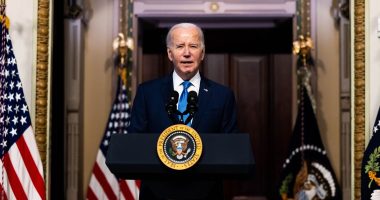
Looking out his window at the Arnold Arboretum at Harvard University, Ned Friedman sees 150 years of history — and also millions. He knows this collection of nearly 16,000 woody plants holds clues on how to navigate an increasingly extreme ecological future.
“When I see a tree, I always end up musing on time,” said Dr. Friedman, who has been the Arnold’s director for 12 years. In the arboretum’s century-and-a-half history — an anniversary it is marking this year — he is only its eighth leader.
There is the timeline of seasonal changes a tree may pass through in any given year, of course — including subtleties that Dr. Friedman urges us to notice, like the purples, pinks and reds of early spring’s ephemeral female conifer cones. And there is time measured in the life span of a species, which may equal many human lifetimes, in cases like that of the majestic white oak (Quercus alba).
“But as an evolutionary biologist, I also start to see other scales of time,” he said.
He was referring to the span measured in thousands of years, since the last ice age moved temperate plants hundreds and thousands of miles from their previous native ranges. And in hundreds of millions of years, since the supercontinent Pangaea began breaking into pieces, moving land masses and pathways of plant genetics.
This extra-long view is not what individual gardeners consider when choosing a particular tree, asking about ornamental features, eventual size and hardiness. But having a fuller picture of its ancestors’ life on Earth makes it even more impressive, Dr. Friedman said.
Looking way back also helps to explain things we may wonder about, including why some conifers are deciduous, dropping their needles in fall — and why some deciduous woody plants hold onto theirs, faded and seemingly useless, all winter.
Have you ever considered why so many species we call Southeastern natives are hardy much farther north, way beyond their current range?
The answers to that and many other questions live in the Arnold’s collection of more than 2,000 species — along with insights into the tenacity required to adapt to tomorrow’s world.
Letting Go, and Holding On
Perhaps your garden is home to a dawn redwood (Metasequoia glyptostroboides), a pyramidal, fast-growing deciduous conifer that can reach 100 feet high and has a distinctively fluted base.
“It’s just sinuous,” Dr. Friedman said. “I could look at those trunks all day long.”
But as recently as 75 years ago, there was no such tree in North America.
Each species tells its own tale of resilience and long-haul survival strategies. The dawn redwood, depicted in the arboretum’s logo, is often referred to as a living fossil. That’s because, until the 1940s, when an extant grove was discovered in China, it was thought to be extinct.
Seed sent to the Arnold in 1948 resulted in the first of those trees to grow in North America in more than two million years.
Why would a conifer be deciduous? Conifer or otherwise, there could be various reasons for dropping your leaves, Dr. Friedman said.
In the tropics, deciduousness evolved in response to dry seasons, as plants rest when water is scarce. And for a few conifers, it was a response, millions of years ago, to the challenge of keeping leaves alive at high latitudes, through the winter months of darkness and cold.
“It’s a cost-benefit analysis,” Dr. Friedman said. “It was a better business model to get rid of the needles every year.”
Why deciduous woody plants, including some oaks, beeches and witch-hazels, hold onto so much old baggage all winter is not as well understood. Do the faded leaves persist as a barrier to deer browsing, or are they retained to drop just in time to serve as mulch in spring?
The phenomenon is known as marcescence — a beautiful word, and a delicate matter: To prevent leaf drop, the plant must keep the tiniest bit of each leaf stalk, or petiole, alive through months of cold. One wintertime example, and a favorite of Dr. Friedman’s, is Chinese spicebush (Lindera angustifolia), which shows off its pleasingly tan foliage in the off season.
One wonders what trigger set such a tricky bit of engineering into development.
‘They’ve All Just Marched North’
Being deciduous is not for everyone. The coastal redwood of California (Sequoia sempervirens) and the giant sequoias in the Sierras (Sequoiadendron giganteum), both kin to the dawn redwood, are evergreen.
But their cousin diverged from that path, Dr. Friedman said, “wandering off, at some point in its evolutionary history, to a point in time where losing your needles turned out to be advantageous.”
Trees move, you see. Slowly, yes, but they move.
It wasn’t very long ago in evolutionary terms that there were no trees where the arboretum is — or anywhere in the Northeast, north of New York City or thereabouts.
Some 18,000 years ago, a sheet of ice covered vast northern swaths, “and all the temperate trees of eastern North America were hanging out in Georgia and Florida,” Dr. Friedman said. “And then — an amazing thing — they’ve just all marched north.”
He added: “They’ve rebounded; they’ve come back in a matter of thousands of years. They just push their seeds north, north, north.”
Spruces and black locust (Robinia pseudoacacia) have already moved impressively. The fringetree (Chionanthus virginicus) continues its journey, too.
Famously, though, the extinct-in-the-wild Franklin tree (Franklinia alatamaha) was among those that did not make it out of its ice age refugium. Today, it is seen only in botanical gardens and private landscapes.
Are those trees and popular Southeastern shrubs like Fothergilla major and bottlebrush buckeye (Aesculus parviflora) hardy up north because they once lived there? Only fossilized pollen records can tell us that.
Whatever the reason, Northeastern gardeners are the happy beneficiaries.
Modern-Day Migrations
Today, glaciers are not among the risk factors prompting migration — but intensifying heat and drought are. The Arnold’s researchers are working to preserve the genetics of pressured plants, especially at the toughest southern edges of their range.
“A species may move and survive, but there may be parts of it that just go extinct,” Dr. Friedman said. “And you lose those genetics.”
Early on, that principle was applied to a different challenge: How could the Arnold’s first director, Charles Sprague Sargent, grow the cedar of Lebanon (Cedrus libani) he lusted after, although it wasn’t hardy in Boston? In seed from a high-altitude Turkish population, the craving was satisfied.
A similar quest is underway with the evergreen Southern live oak (Quercus virginiana). “We just can’t grow the evergreen oaks here,” Dr. Friedman said, an assertion that researchers hope to disprove, starting with acorns collected in the tree’s northernmost range, in Virginia.
“At the end of the day, if we put 200 saplings in and one has the genetics to survive in Boston, it’s a win,” Dr. Friedman said.
A Family Reunion
Three-quarters of the research at the arboretum currently focuses on how trees and forests will function in the face of “human-induced global change, including climate change,” Dr. Friedman wrote recently in Arnoldia, the quarterly membership magazine.
The arboretum’s collection is arranged taxonomically on its 281 acres, with related trees clustered together, which is ideal for studying how various maple species react to increasing drought, for example, or how particular trees handle more freeze-thaw cycles occurring during spring’s leafing-out stage.
“Just like a museum gallery that has a certain kind of art, you want to have that comparative context,” Dr. Friedman said.
The Arnold is also an important collection of what are known as biogeographic disjuncts: closely related plants separated in nature by great distances, thanks to those continental shifts millions of years ago — when sea levels were lower and plants began east-west migrations across continental land bridges that are now submerged.
This is why North America and Asia have so many close cousins among temperate trees and shrubs, including magnolias and viburnums.
After a 14-million-year estrangement, for instance, a Chinese tulip tree (Liriodendron chinense) now lives at the Arnold alongside a North American one (L. tulipifera). The two are so genetically similar that they can cross-pollinate, with hybrid offspring growing happily in their midst.
“A family reunion” — one of many rooted in the ground, and history, of this place — Dr. Friedman noted.
Getting to Know the Arnold
Dr. Friedman regards the Arnold Arboretum as part of Boston’s public health system: a place for exercise and escape. During the pandemic, it has never closed.
The landscape, which is part of Boston’s city park system, was designed by Frederick Law Olmsted (who would have turned 200 in April). It is free, and open 365 days a year. A series of curated walks on the website includes audio, text and photos, guiding visitors in person or virtually.
Each plant has a detailed provenance, including the big-leaf magnolia (Magnolia macrophylla), a tropical-looking creature with the largest flowers and simple leaves of any temperate North American native plant. This is another tree found in the Southeast today, but hardy enough to grow farther north.
There is future-facing inspiration, too. The arboretum has ambitious solar installations, on taller-than-average frames designed to accommodate exuberant pollinator habitats around and beneath them.
Margaret Roach is the creator of the website and podcast A Way to Garden, and a book of the same name.
For weekly email updates on residential real estate news, sign up here. Follow us on Twitter: @nytrealestate.
Source: | This article originally belongs to Nytimes.com









